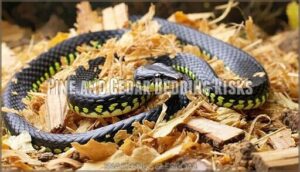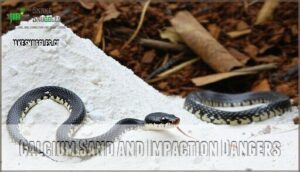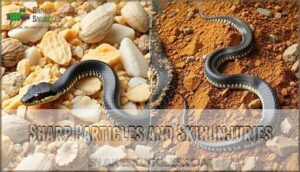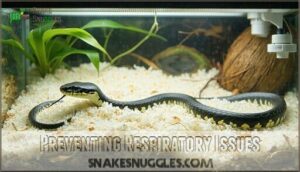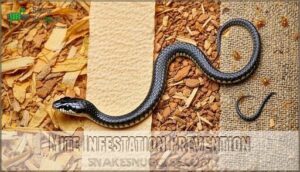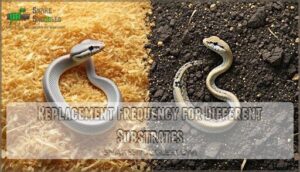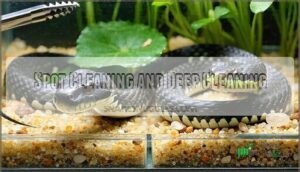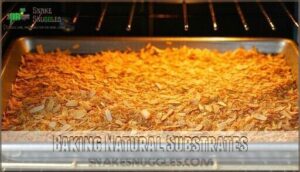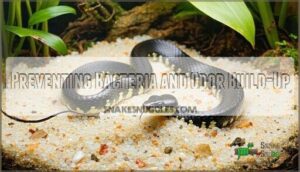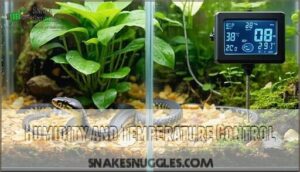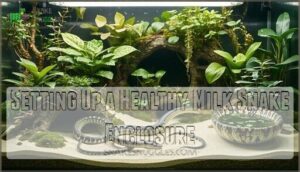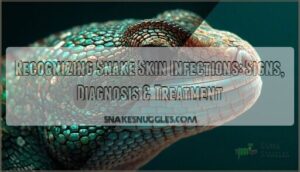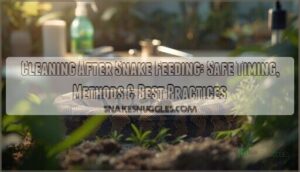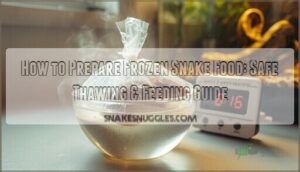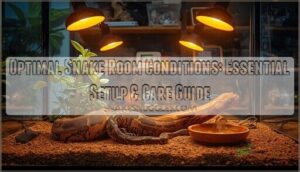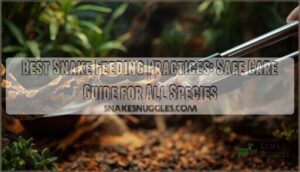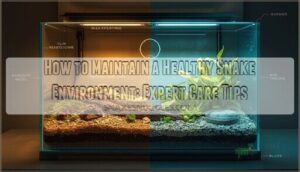This site is supported by our readers. We may earn a commission, at no cost to you, if you purchase through links.
 You’ll find five standout substrates that make excellent choices for your milk snake’s home.
You’ll find five standout substrates that make excellent choices for your milk snake’s home.
Paper-based bedding offers foolproof safety and easy cleanup, while reptile carpet provides a reusable, belly-friendly surface.
For natural burrowing enthusiasts, cypress mulch and coconut husk deliver superior moisture control and digging opportunities.
Aspen wood shavings strike a nice balance with odor control and tunneling support.
Each substrate brings unique benefits, but certain materials like pine, cedar, and calcium sand can spell trouble for your serpent friend’s health.
Table Of Contents
Key Takeaways
- You’ll want to stick with safe substrates like aspen shavings, cypress mulch, coconut husk, reptile carpet, or paper bedding that support natural burrowing without health risks
- You must avoid pine, cedar, and calcium sand substrates since they cause respiratory problems, skin irritation, and dangerous digestive blockages
- You’ll need to maintain proper humidity levels between 40-60% by choosing substrates with appropriate moisture retention for your snake’s comfort
- You should replace substrates regularly – paper bedding every 1-2 weeks, wood-based options every 3-6 weeks – and spot clean daily to prevent bacterial growth
Best Substrates for Milk Snakes
Choosing the right substrate for your milk snake directly impacts their health, comfort, and natural behaviors.
You’ll want to select bedding that maintains proper humidity levels while allowing for easy cleaning and safe burrowing opportunities, which is crucial for their overall comfort.
Paper-Based Bedding
Starting with paper-based bedding transforms your milk snake’s habitat into a clean, manageable environment.
This cost-effective substrate offers excellent absorbency levels while providing superior odor control for your pet’s enclosure.
You’ll appreciate the beginner friendliness since replacement requires minimal effort—simply dispose of soiled sections weekly.
Paper-based bedding ranks as the safest substrate choice, eliminating ingestion risks that concern new snake owners.
Paper-based bedding eliminates dangerous ingestion risks that worry new snake keepers
You can easily find quality bedding options online, which is a great way to get started with a clean environment.
Reptile Carpet
Reptile Carpet offers a reusable solution that’s gentler on your milk snake’s delicate belly than rough paper towels.
You’ll find this woven substrate easy to clean with soap and water, though proper Carpet Hygiene requires bi-weekly washing cycles.
Choose carpets with tightly woven fibers to prevent Fiber Dangers like loose threads catching your snake’s scales.
Secure Placement prevents bunching that creates hiding spots for bacteria or mites. It’s also important to verify substrate safety considerations and make certain a healthy environment is maintained with proper care and secure placement.
Cypress Mulch
Cypress mulch stands out as an exceptional substrate choice that ticks all the right boxes for milk snake care.
This natural bedding excels at humidity retention while preventing mold growth through excellent drainage properties.
Here’s why cypress mulch deserves serious consideration for your substrate selection:
- Superior moisture retention – Maintains good humidity control without creating soggy conditions
- Natural burrowing support – Lightweight particles allow comfortable tunneling behavior
- Optimal particle size – Large enough to prevent accidental ingestion during feeding
- Sustainable source – Environmentally responsible choice from renewable cypress trees
- Effective mold prevention – Natural antifungal properties keep enclosures healthier longer
Some keepers use it to create snake habitat enrichment.
Coconut Husk
Coconut husk substrate offers excellent moisture retention, helping you maintain consistent humidity levels for your milk snake.
The fibrous texture supports natural burrowing behavior while allowing proper airflow to prevent mold growth.
Husk particle size varies between brands, so choose medium-sized chunks that won’t cause impaction, making it a cost-effective option that requires monthly replacement.
This option works particularly well for snakes needing higher humidity environments. You can purchase quality substrate from various online retailers.
Aspen Wood Shavings
Aspen Wood Shavings offer excellent Odor Control and support natural Tunneling Behavior for your milk snake.
This Recommended Substrate maintains low Dust Content when sourced from reputable suppliers, ensuring Snake Safety.
You’ll find various Sourcing Options at pet stores and online retailers.
These Aspen Shavings create an ideal Snake Substrate that’s both practical and species-appropriate for milk snakes.
Popular Commercial Substrates (Zoo Med, ReptiChip, Galapagos)
Leading commercial brands offer reliable substrate options for your milk snake.
Zoo Med Aspen provides dust-free, odorless bedding that’s highly absorbent. ReptiChip Moisture-retaining coconut chips last 2-3 months with proper maintenance. Galapagos Cypress naturally resists bacteria while maintaining consistent humidity levels.
These recommended substrates undergo commercial testing for safety, with market surveys showing 90% satisfaction rates for substrate performance and burrowing support.
Substrates to Avoid and Safety Tips
While choosing the right substrate keeps your milk snake healthy, picking the wrong one can seriously harm your pet.
Understanding which bedding materials to avoid protects your snake from respiratory problems, skin injuries, and potentially fatal digestive blockages, which is crucial for maintaining your pet’s overall health and preventing digestive blockages.
Pine and Cedar Bedding Risks
You shouldn’t use pine and cedar bedding for your milk snake because these woods contain toxic oils that cause respiratory irritation and skin damage.
The aromatic compounds can lead to serious respiratory issues and long-term health problems.
Cedar shavings are particularly dangerous as substrate to avoid due to their concentrated oils.
Safe alternatives like aspen shavings or cypress mulch provide better health outcomes without these health dangers.
Calcium Sand and Impaction Dangers
Calcium sand poses serious health dangers for milk snakes through impaction risks.
Calcium sand creates deadly blockages – choose safer alternatives for your snake’s health
When ingested during feeding or exploration, this substrate reduces stomach acid production, preventing safe digestion.
Impaction symptoms include loss of appetite, lethargy, and constipation requiring immediate veterinary intervention.
Hydration importance increases with calcium sand exposure.
Choose alternative substrates like aspen shavings for reptile substrate safety to mitigate these risks, ensuring the well-being of the milk snakes by preventing serious health dangers.
Sharp Particles and Skin Injuries
Beyond impaction risks, substrate texture matters just as much for your milk snake’s wellbeing.
Sharp-edged materials can slice delicate belly scales during normal movement, creating painful wounds that invite bacterial infections.
Avoid these abrasive materials that threaten injury prevention:
- Crushed walnut shells with jagged fragments
- Gravel or aquarium rocks with rough surfaces
- Recycled glass substrates containing sharp particles
Choose safe substrate options with smooth particle size instead.
Your snake’s skin will thank you for prioritizing reptile substrate safety over aesthetics.
Proper substrate selection prevents both skin irritation and serious health dangers that could require expensive veterinary treatment.
Preventing Respiratory Issues
Respiratory health depends on choosing substrates that minimize dust and harmful particles.
Fine dust from low-quality aspen shavings can irritate your milk snake’s airways, while aromatic oils in cedar create serious breathing problems.
Maintain proper ventilation with screen lids and adequate airflow control.
Monitor humidity levels carefully—excessive moisture promotes mold growth that worsens respiratory issues.
Select dust-free, safe substrates for ideal respiratory health, and ensure to avoid materials like cedar that can cause serious breathing problems due to their aromatic oils, and also be mindful of the quality of aspen shavings to prevent airway irritation.
Mite Infestation Prevention
Mite infestations can turn your snake’s home into a nightmare if you’re not careful.
Quarantine newcomers for at least 30 days before introducing them to your main collection. Regular inspections help you spot these tiny troublemakers early.
Choose mite-resistant substrates like paper towels or reptile carpet that don’t provide hiding spots for these pests.
Proper ventilation prevents the humid conditions mites love, while maintaining a healthy environment through consistent substrate replacement frequency keeps your milk snake comfortable and pest-free.
Mites can also act as disease transmission vectors to spread disease.
Substrate Maintenance and Hygiene
Proper substrate maintenance keeps your milk snake healthy and prevents dangerous bacterial growth in their enclosure.
You’ll need to follow specific cleaning schedules and techniques that vary depending on which bedding type you’ve chosen.
Replacement Frequency for Different Substrates
Different substrates demand varying cleaning frequency schedules for ideal milk snake health.
Paper-based bedding requires complete changes every 1-2 weeks due to rapid waste absorption.
Reptile carpet needs weekly washing with full replacement every 3-6 months.
Cypress mulch and coconut husk substrate replacement occurs every 4-6 weeks to prevent mold growth.
Aspen wood shavings typically need complete changes every 3-4 weeks for proper hygiene maintenance.
Following proper substrate maintenance schedules prevents bacterial growth and mite infestations effectively.
Spot Cleaning and Deep Cleaning
Beyond regular bedding changes, you’ll need daily maintenance to keep your milk snake healthy.
Spot cleaning removes waste immediately, preventing bacterial growth that threatens your pet’s well-being.
Here’s your daily cleaning routine:
- Daily Checks – Inspect substrate for waste, shed skin, or uneaten food
- Waste Removal – Remove soiled bedding using tongs or gloves immediately
- Odor Control – Replace wet spots that harbor bacteria and create smells
- Safe Cleaners – Use reptile-safe disinfectants for spot treatment when needed
Baking Natural Substrates
Sterilizing natural substrates like coconut husk and Aspen wood shavings prevents pest elimination issues before adding them to your milk snake’s enclosure. You’ll want to spread substrate evenly on a baking sheet and heat at safe temperatures of 200°F for 30-45 minutes.
This baking duration effectively kills mites, bacteria, and parasites without damaging the substrate’s natural properties. After baking, allow complete cooling before use, ensuring your snake’s substrate maintenance routine starts with the cleanest possible foundation.
| Substrate Types | Safe Temperatures | Baking Duration |
|---|---|---|
| Coconut Husk | 200°F (93°C) | 30-45 minutes |
| Cypress Mulch | 200°F (93°C) | 30-45 minutes |
| Aspen Wood Shavings | 200°F (93°C) | 30-45 minutes |
| Bark Chips | 225°F (107°C) | 45-60 minutes |
Preventing Bacteria and Odor Build-Up
Three simple steps keep your milk snake’s substrate fresh and odorless.
First, establish weekly cleaning schedules with daily spot-cleaning of waste areas to prevent bacterial growth.
Second, choose absorbent substrates like aspen that naturally control odor while maintaining proper sanitization methods.
Third, implement hygiene protocols including monthly deep cleaning and bacterial testing if issues arise, ensuring your safe substrate environment stays healthy.
Humidity and Temperature Control
Your milk snake’s health depends on maintaining precise humidity levels between 40-60% and a proper temperature gradient.
The substrate you choose directly affects moisture retention and your ability to create the ideal microenvironment for your snake’s comfort and well-being.
Ideal Humidity Levels for Milk Snakes
Most milk snakes thrive with humidity levels between 40-60%, measured using digital humidity gauges for environmental stability.
Honduran subspecies prefer higher moisture control at 60-80%.
During shedding, boost ideal humidity to 70% supporting proper snake hydration.
Monitor daily with hygrometers placed mid-enclosure.
Low humidity causes stuck sheds while excessive moisture triggers respiratory issues, making consistent humidity control essential for your snake’s health.
Maintaining the right environment is vital, especially for species that exhibit heat sensitive pits behavior.
Moisture Retention of Substrates
Understanding substrate absorbency helps you maintain proper humidity control for your milk snake’s health.
Different materials offer varying water retention capabilities that directly impact moisture levels in the enclosure.
Here’s how substrates handle moisture retention:
- Cypress mulch – Excellent water retention, slowly releases moisture for consistent humidity control
- Coconut husk – Superior moisture-retentive properties, ideal for hydration management needs
- Aspen shavings – Moderate substrate absorbency, good for drier environments
- Paper bedding – Low moisture retention, requires frequent misting for proper humidity levels
Choose substrates based on your snake’s specific moisture requirements and your substrate maintenance preferences.
Monitoring and Adjusting Humidity
Proper humidity monitoring requires quality humidity sensors placed at snake level, not near heat sources.
Digital hygrometers need monthly calibration with salt tests to guarantee accuracy. Check moisture levels twice daily, adjusting water bowl size and substrate misting as needed.
Milk snake humidity should stay between 40-60%, with evaporation rates varying by substrate choice and room conditions.
Maintaining ideal humidity levels involves understanding humidity control strategies to guarantee the health and well-being of the snakes, using quality humidity sensors and applying humidity control strategies.
Temperature Gradient and Enclosure Setup
You’ll need proper thermal gradients for your milk snake’s health.
Create a warm side at 80-85°F and cool side at 70-75°F using under tank heaters (UTHs).
Your enclosure size should be at least 1.5 times your snake’s length.
Position snake hiding spots on both temperature zones.
Make certain good ventilation systems prevent stagnant air while maintaining climate control.
Setting Up a Healthy Milk Snake Enclosure
Once you’ve chosen the perfect substrate for your milk snake, you’ll need to create an enclosure that supports their natural behaviors and health needs.
The right setup combines proper sizing, strategic placement of accessories, and attention to your snake’s instinctive requirements for security and comfort.
Enclosure Size and Design
Your milk snake’s home should provide room to stretch and explore without feeling lost in a mansion.
Choose Tank Dimensions that allow at least 1.5 times your snake’s length for comfortable Snake Movement. A 40-gallon long tank works well for most adults.
Smart Enclosure Design includes proper Ventilation Systems with mesh tops and side vents. Focus your Habitat Setup on creating secure zones rather than open spaces that stress your pet.
Feeding Enclosure Considerations
Anyone can set up a proper Feeding Enclosure to prevent substrate ingestion during mealtime.
Create a separate feeding space with paper towels lining the bottom instead of loose bedding. When designing the enclosure, consider the importance of a suitable temperature gradient for the snake’s health.
Essential Feeding Enclosure Setup elements:
- Secure Lid Options – Use tight-fitting covers to prevent escapes during feeding sessions
- Substrate Free Zones – Line with paper towels or butcher paper for easy cleanup
- Feeding Tray Materials – Choose smooth surfaces that won’t harbor bacteria or create hiding spots
Hiding Places and Accessories
Beyond your feeding setup, you’ll want to create secure retreats that make your milk snake feel at home.
These shy creatures need multiple hiding spots to regulate stress and temperature effectively.
| Hide Type | Placement & Purpose |
|---|---|
| Rock Caves | Warm side for thermoregulation |
| Hide Boxes | Cool side for temperature control |
| Visual Barriers | Block sight lines between hides |
| Climbing Structures | Vertical space for exercise |
| Foliage | Natural cover throughout enclosure |
Place hiding places on both warm and cool sides of your terrarium.
Your snake will shuttle between them like a living thermostat.
Dense artificial foliage creates natural visual barriers, while a sturdy climbing branch adds vertical territory.
Choose terrarium accessories that won’t tip over when your snake explores underneath.
Water Dish Placement
Your milk snake’s water dish placement directly affects both Snake Hydration and Humidity Control throughout the enclosure.
Strategic Dish Location helps your snake stays healthy while maintaining proper Milk snake humidity levels.
Consider these three Enclosure Placement guidelines:
- Cool side positioning – Place the Water Dish on the cool side to prevent excessive evaporation
- Away from Hiding Places – Position it where your snake can easily access without feeling exposed
- Stable surface – Support Water Bowl Safety by using a heavy, tip-resistant dish
This Enclosure Layout supports ideal Humidity levels.
Supporting Natural Behaviors
Your substrate choice directly impacts your milk snake’s ability to express natural behaviors.
Burrowing behavior thrives with aspen shavings or coconut husk that allows tunneling.
These substrates support thermal gradients while providing humidity control through moisture retention.
Creating a snake habitat that mimics natural environments encourages healthy activity patterns and reduces stress in captivity.
Frequently Asked Questions (FAQs)
Can milk snakes eat substrate accidentally during feeding?
Ironically, these seemingly harmless serpents can turn mealtime into a sandy nightmare.
Yes, you’ll find milk snakes accidentally ingesting substrate during feeding, especially with loose materials like sand or wood chips.
That’s why you should use separate feeding enclosures lined with paper towels to prevent this issue, making mealtime less of a nightmare.
How deep should substrate be for milk snakes?
You’ll want to provide 2-3 inches of substrate depth for your milk snake.
This allows comfortable burrowing behavior while preventing excessive tunneling that could collapse hiding spots or create unsafe conditions.
Can I mix different substrates together safely?
Like mixing paint colors on a palette, you can safely combine compatible substrates for your milk snake.
Blend aspen shavings with coconut husk or cypress mulch to balance burrowing ability with humidity retention, creating an ideal environment.
What substrate works best for breeding milk snakes?
You’ll want paper towels or newspaper for breeding setups since they’re sterile, easy to monitor for eggs, and won’t harbor bacteria that could harm developing offspring or complicate incubation conditions.
Conclusion
Choosing the best substrates for milk snakes mirrors finding the perfect foundation for your home – it must support everything above it.
Paper-based bedding, reptile carpet, cypress mulch, coconut husk, and aspen shavings each offer distinct advantages for your snake’s health and comfort.
Avoid pine, cedar, and calcium sand substrates that pose serious health risks.
Regular maintenance, proper humidity control, and monitoring your snake’s behavior will guarantee your substrate choice supports their natural instincts and overall wellbeing throughout their life.
- https://www.petmd.com/reptile/milk-snake-care-sheet
- https://www.galapagospet.com/animals/milk-snake/?srsltid=AfmBOorD2i8fujK5PI2RiwvLHeUaLFNeDrwmwxXiExFrI38PUura9qUP
- https://www.petsmart.com/learning-center/reptile-care/snake-care-guide-how-to-take-care-of-a-pet-snake./A0042.html
- https://talis-us.com/blogs/news/repti-fogger-the-ultimate-fogger-for-reptile-terrariums
- https://www.instagram.com/dr.lyle.dvm/

